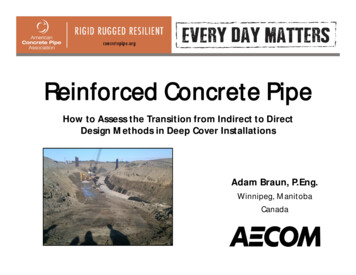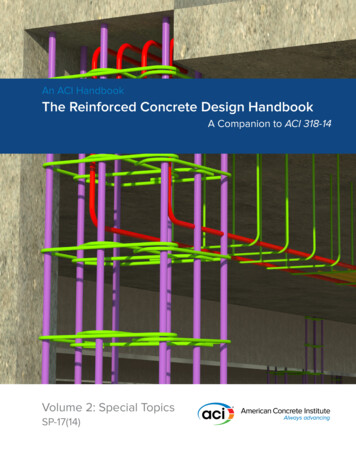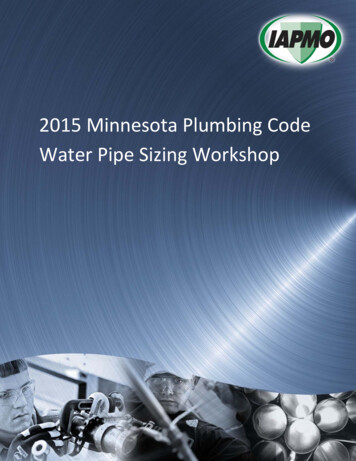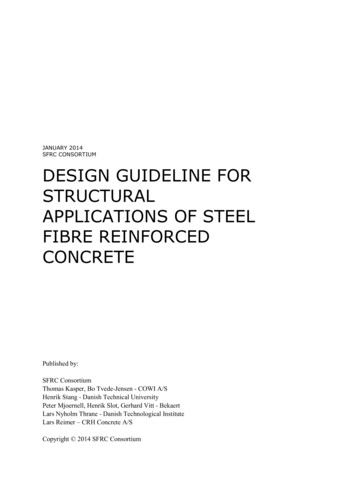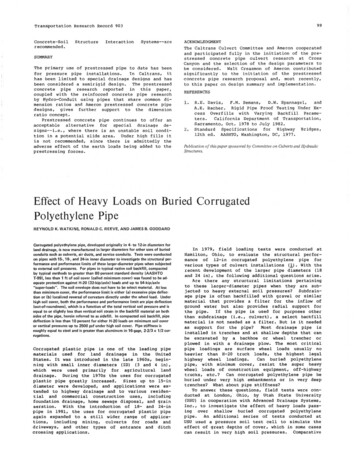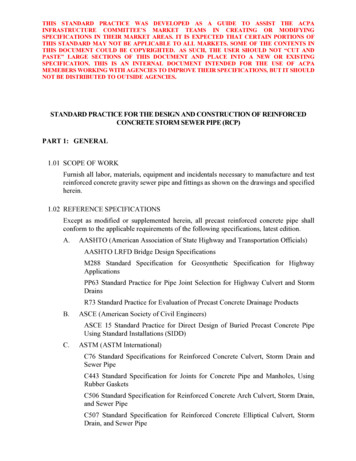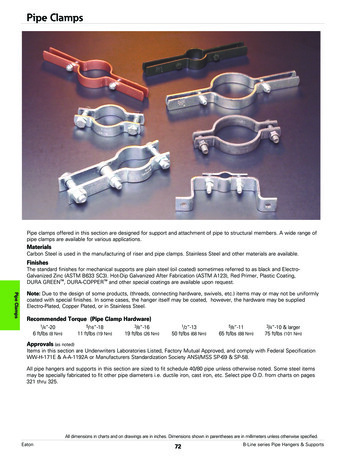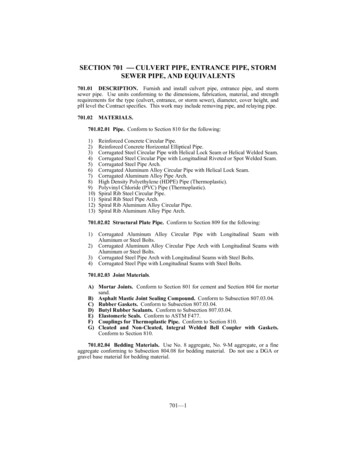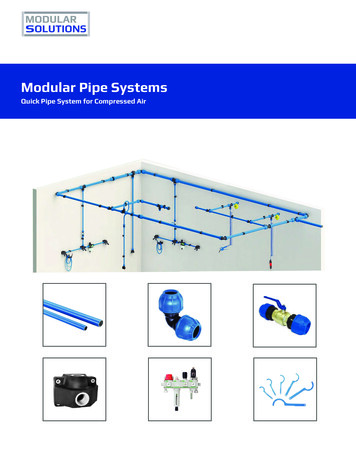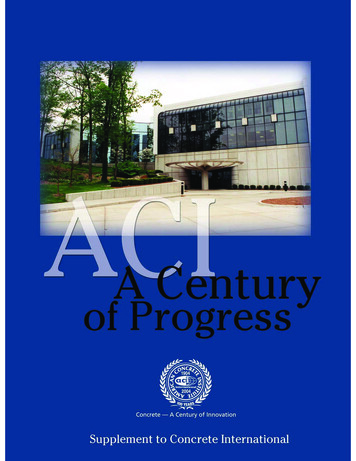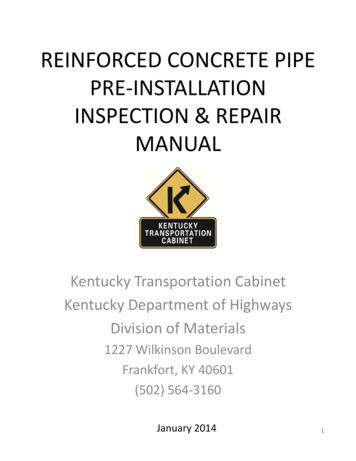
Transcription
REINFORCED CONCRETE PIPEPRE‐INSTALLATIONINSPECTION & REPAIRMANUALKentucky Transportation CabinetKentucky Department of HighwaysDivision of Materials1227 Wilkinson BoulevardFrankfort, KY 40601((502)) 564‐3160January 20141
Kentucky Transportation Cabinet“Disclaimer Statement”The information and photographs provided herein are intended to beused as a “guideline” for the inspection and repair of reinforced concretepipe prior to installation. This manual is NOT a substitute for currentspecifications special notes,specifications,notes or other official documents contained incontract proposals or scopes of work. This manual may be modified atany time by the Kentucky Transportation Cabinet to accommodatechanges in policy, procedure, or specification. Questions regarding thismanual can be directed to the Kentucky Transportation Cabinet, Divisionof Materials, Concrete and Physical Properties Section at (502) 564‐3160.2
Table of ContentsI. Standards & SpecificationsII. Acceptancep& Repairp GuidelinesIII. WorkmanshipIV. ConsolidationV Surface TearsV.VI. Bell and SpigotVII. CracksVIII. Exposedd Steell andd InsufficientffCoverIX. Material HandlingX. Repair Examples3
I. Standards & Specifications Kentucky Transportation Cabinet Department of Highways StandardSpecifications for Road and Bridge Construction details specifications forreinforced concrete pipe Section 701 – Culvert Pipe,p Entrance Pipe,p Storm Sewer Pipe,p andEquivalents Section 810 – Pipe and Pipe ArchesSections 701 and 810 refer to several individual AASHTO specifications M170: Standard Specification for Reinforced Concrete Culvert, StormDrain, and Sewer Pipe (ASTM C76) M206: Standard Specification for Reinforced Concrete Arch Culvert,CulvertStorm Drain, and Sewer Pipe (ASTM C506 with differences) M207: Standard Specification for Reinforced Concrete Elliptical Culvert,Storm Drain, and Sewer Pipe (ASTM C507 with differences) M242: Standard Specification for Reinforced Concrete D‐Load Culvert,Storm Drain, and Sewer Pipe (ASTM C655 with differences)Kentucky Method 64‐115:64 115: Approval Process for Producers of Culvert Pipedetails the approval process for producers of culvert pipe.The List of Approved Materials (LAM) lists the approved “Concrete PipeProducers.”The standard specifications, KM 64‐115 and the LAM are all available at ourwebsite: lt.aspxThe following representations and pictures in Sections III through X willuse the following categories:ACCEPT – GreenREPAIR(1) – OrangeREJECT(2) – RedQUESTIONABLE: ENGINEER’S DECISION ‐ Blue(1)(2)If the contractor/producer elects not to repair the pipe then thepipe will be rejected.Pipe that is rejected will not be used on a KYTC projectproject.4
II. Acceptance & Repair GuidelinesScopeReinforced concrete pipe production is an imperfect operation and occasionally pipecomes from the mold in need of repair or outright rejection.rejection Pipes are often damagedduring handling prior to and during the installation process. This document providesguidance for the repair of reinforced concrete pipe at the manufacturing facility andat the project site. This manual provides guidance to determine whether to repair orreject reinforced concrete pipe. Repairs will be acceptable if, in the opinion of theEngineer, the repairs are sound, properly finished and cured and the repaired pipeconforms to the requirements of this document. Structural repair must be completedby the producer using materials and methods approved by the Division of Materials.Pipe repairs that only require cosmetic repair procedures may be completed by thecontractor or the producer unless otherwise stated.Producers are required to submit a plant Quality Control plan and concrete mixdesign(s) to the Division for review and approval as per KM 64‐115.Producers must appear on the List of Approved Materials.GeneralAny repairs required beyond the scope of this document may be submitted to theDirector of the Division of Materials for evaluation on a case‐by‐casecase by case basis.basis Suchrepair proposals should include a photograph or sketch of the affected area and adetailed repair proposal.The QC inspector must document additional information in the plant book when apipe is rejected. The date of manufacture, lot number, size, quantity and reason forrejection must be included. Rejected pipe or pipe requiring repair should be clearlymarked in a location to prevent the defective pipe from mistakenly being shipped orinstalled.Repairs to pipe should be properly finished, cured, and sound. Structural repairs to‘extra protection’ pipe (Section 810.03.05) must be witnessed by the Departmentinspector.5
II. Acceptance & Repair GuidelinesDefinitionsDefinitions of terms relating to concrete pipe, see AASHTO M 262.AASHTOAmerican Association of State Highway and TransportationOfficialsLAMList of Approved MaterialsKMKentucky MethodRCPPrecast reinforced concrete pipeDivisionDivision of MaterialsEngineerResponsible Department EngineerPipeIndividual joint or section of RCPProducerManufacturer included on the LAMSpallDamage to hardened concreteStructural RepairDepths 0.5 inch and greater, reinforcement steel isexposed.Cosmetic RepairDepth range up to 0.5 inch, reinforcing steel is not exposed.6
II. Acceptance & Repair GuidelinesAcceptanceKentucky Department of Highways Standard Specifications for Road and Bridgepfor reinforced concrete pipep p in Section 701 –Construction details specificationsCulvert Pipe, Entrance Pipe, Storm Sewer Pipe, and Equivalents, and in Section 810 –Pipe and Pipe Arches. These two sections refer to several individual AASHTOstandards, including M170 (ASTM C76), M206 (ASTM C506), M207 (ASTM C507) andM242 (ASTM C655). KM 64‐115 details the approval process for producers of culvertpipe. Cover Height Standard Drawings are numbered RDI‐001 through RDI‐012. TheLAM lists the approved producers of concrete pipe.The standard specifications, KM 61‐115 and the LAM are all available at our es/default.aspx .Department guidance to the above specifications are included in this document.Other guidance or direction may be provided by the Engineer and communicated tothe Producer and Contractor on an individual basis.RejectionPipe shall be subject to rejection if it fails to conform to any of the specificationrequirements. Pipe may be rejected because of any of the following: Fractures or cracks passing through the wall, except for a single end crack thatdoes not exceed the depth of the joint. Defects that indicate problems with proportioning, mixing, and molding, orsurface defects indicating honey‐combed or open texture that would adverselyaffect the function of the pipe or long term integrity of the pipe. Damaged or cracked ends, where such damage extends into the gasket surfacearea leading to a questionable joint seal. End cracks greater than 0.01 inch inwidth at any point in the gasket surface area will be a cause for rejection. Any continuous crack having an unloaded surface width of 0.01 inch or more andextending for a length of 12 inches or more, regardless of position in the wall oftheh pipe.i AnyA continuousicrackk havingh i an unloadedl d d surfacefwidthid h lesslthanh 0.010 01inch may be accepted at the discretion of the Engineer. Verify the 0.01 inch cracklimit with a feeler gauge conforming to the requirements of AASHTO T 280.7
II. Acceptance & Repair GuidelinesStructural Repair Procedures (By Producer Only) Areas to be repaired must be clean, sound and free of contaminants. Make a vertical surface along the perimeter of the damaged area. Remove concrete for a minimum of 1 inch behind all exposed reinforcementwhere at least 2 inches of continually exposed reinforcement is visible. Provide an aggregate fractured surface. Clean the repair surface. Apply an approved bonding agent unless the manufacturer’s instructionsexpressly state that a bonding agent is not required. Fill the area with anapproved repair material in accordance with the Manufacturer’srecommendations.recommendations Cure the repaired area either in accordance with the manufacturer’srecommendations, or, in accordance with the approved quality control plan for aminimum of 24 hours. Evaluate the repaired area by applying a moderate blow with a 16 ouncehammer at several locations within the repaired area. The repaired area should closely match both the texture and integrity of theundamaged adjacent concrete surfaces.8
II. Acceptance & Repair GuidelinesCosmetic Repair Procedures (By Producer or Contractor) Areas to be repaired must be clean, sound and free of contaminants. Provide an aggregate fractured surface. Saturate the repair surface with clean water to provide a SSD condition whenapplicable. Fill the area with a thoroughly mixed approved repair material in accordancewith the manufacturer’s recommendations, or a mortar mix. Cure the repaired area in accordance with the manufacturer’s recommendationsfor a minimum of 24 hours. Evaluate the repaired area by applying a moderate blow with a 16 ouncehammer at several locations of the repaired area.area The repaired area should closely match both the texture and integrity of theundamaged adjacent concrete surfaces.9
II. Acceptance & Repair GuidelinesEnd Spalls and Damage Spalls/chips/damage on the bell or spigot, which do not affect the gasketsurface shall not be cause for rejectionsurface,rejection, provided the circumferential length of asingle spall on the pipe end is not more than ¼ the inside diameter or thecircumferential length of multiples spalls combined does not exceed ½ of theinside pipe diameter, and reinforcing steel is not exposed. If the spall(s) meet the criteria above but the surface of the circumferentialreinforcing steel is exposed then the pipe may be repaired in the field by othersunder the supervision of the Engineer. The area must be clean and sound.Asphalt mastic is to be applied to the damaged area with sufficient coverage toprotect the reinforcing steel. If the gasket contact surface is damaged, the circumferential length of a singlespall may not exceed ¼ the inside diameter or the total circumferential length ofmultiple spalls combined may not exceed ½ of the inside pipe diameter. Ifreinforcing steel is not exposed then the pipe may be repaired in accordancewith the cosmetic repair procedures. If the reinforcing steel is exposed then thepipe may be repaired in accordance with the structural repair procedures. Pipes with end spalls that do not meet the criteria above are to be rejected.10
II. Acceptance & Repair GuidelinesSpalls, other than End Spalls Repairs to the inner and outer barrel will be permitted as follows: A spalled area that does not reveal the reinforcing steel may be repaired inaccordance with cosmetic repair procedures. A spalled area that does reveal thereinforcing steel may be repaired in accordance with the structural repairprocedures. The spalled area may not exceed the surface area limits in the tablebelow. If more than one spall is present then the total surface area of the spallscombined may not exceed the surface areas limits in the table below. Spalling to the barrel which exceeds these limits may be rejected. Acceptancewith repair will only be permitted based on a case‐by‐case evaluation by theEngineer.Total Surface AreaLimits(square inches)Pipe ID Structural Cosmetic(inches) 470Total Surface AreaLimits(square inches)Pipe ID Structural 39879613841683214443486811
II. Acceptance & Repair GuidelinesSpalls Around Lift Holes Minor spalls less than 2 inches from the edge of the lift hole may be repaired inaccordance with cosmetic repair procedures.procedures The aggregate fractured surfaceneed not be obtained. Reinforcing steel may be visible prior to completing therepair. Minor spalls developed at the lift hole during installation may be repaired at thesame time the lift hole is plugged. Repairs are to be made by others under thesupervision of the Engineer using repair materials from the LAM. Major spalls greater than 2 inches on the outer barrel around the lift hole whichdo not expose the reinforcement may be repaired in accordance with thecosmetic repair procedures. Major spalls greater than 2 inches on the outer barrel around the lift hole whichreveal the reinforcement must be repaired in accordance with the structuralrepair procedures. Major spalls must be repaired by the Producer using repairmaterials from the LAM.12
II. Acceptance & Repair GuidelinesCracks: Through Wall Cracks Reject pipe sections exhibiting a through wall crack, except a single end crackp of the jjoint. Pipep sections rejectedjfor cracks mayythat does not exceed the depthnot be repaired.C k Non‐throughCracks:Nhh WallW ll CracksC k Any pipes which exhibit non‐through wall crack(s) having a surface width lessthan 0.01 inch will be accepted. Pipes exhibiting non‐through wall cracks greaterthan or equal to 0.01 inch in width and 12 inches or more in length will berejected. Pipe sections rejected for cracks may not be repaired.13
II. Acceptance & Repair GuidelinesManufacturing DefectsHoneycombing, consolidation, and other mixture defects: Pipe exhibiting honeycombing or mixture defects that do not expose thereinforcing steel may be repaired using the cosmetic repair procedures. Pipe exhibiting honeycombing or mixture defects that do expose the reinforcingsteel may be repaired using the structural repair procedures. The maximum unconsolidated area allowed to be repaired may not exposereinforcing steel or exceed the surface area limits in the table below. Pipes with defects which exceeds these limits may be rejected. Acceptance withrepair will only be permitted based on a case‐by‐case evaluation by the Engineer.Total Surface AreaLimits(square inches)Pipe ID(inches)151824303642485460667278Cosmetic Repair90109145181217253289326362398434470Total Surface AreaLimits(square inches)Pipe ID(inches)849096102108114120126132138144Cosmetic Repair50654357961565168772376079683286814
II. Acceptance & Repair GuidelinesManufacturing DefectsBug Holes: Very small surface voids are normally considered a cosmetic defect that does notrequire repair except under the following circumstances: Large surface voids over 0.5 inch in diameter or clusters of bug holescovering an area larger than 100 in² and reinforcing steel is not exposedare required to be repaired using the cosmetic repair procedures. All bug holes that expose reinforcing steel may affect the performance ofthe pipe and must be repaired using the structural repair procedures. Repairs are to be made by the Producer using repair materials from the LAM.Plastic “Tear”Tear Cracks:Occasionally, concrete pipe develops ‘tear’ cracks at their surface during initialmanufacturing/handling, prior to curing, when tensile stresses exceed the concretestrength. These cracks are predominantly located along the shoulder of the spigotjoint where the pipe transitions to full wall depth, although minor cracking located onthe outer barrel or the pipe end may occur less frequently. The concern is that the crack exposes the reinforcing steel and/or the bondbetween the concrete and the reinforcing steel may be compromised to an extentwhich is not visible. Shoulder or outer barrel tear cracks through the pipe wall shall be cause forrejection and are not repairable. For all other tear cracks, acceptance will be the Engineer’s decision based on theextent of the tear crack. Shoulder tear cracks or outer barrel tear cracks eligible for repair must be repairedby v‐grooving along the length of the crack. Complete the repair following thestructurall repairi procedures.d The repair of tear cracks must be made by the Producer using repair materialsfrom the LAM.15
II. Acceptance & Repair GuidelinesManufacturing DefectsExposed Circumferential Steel on Pipe End:A 0.25 inch minimum cover is required for circumferential reinforcement on pipeends. Occasionally the surface of the circumferential steel is exposed on the pipeends. This happens due to manufacturing error. The exposed steel must be protected.If the length of exposed steel is less than 12 inches it may be repaired in the field byothers under the supervision of the Engineer. The area must be clean and sound.Asphalt mastic is to be applied to the damaged area with sufficient coverage toprotect the reinforcing steel. If the exposure length is greater than 12 inches the pipeshall be rejected.Exposed “End Tips”:The presence of exposed longitudinal “end tips” of the reinforcing cage at the pipeends or spacers on the pipe wall shall not be cause for rejection. If there are small airgaps around this visible steel, asphalt mastic can be applied to protect the steel or theair gaps can be repaired following the cosmetic repair procedures. An aggregatefractured surface is not required.Cage Shadow:SSome manufacturingf t i processes may reveall ththe reinforcingi f i cage even ththoughh ththesection has sufficient cover. If the inspector is concerned about insufficient cover, theProducer shall be responsible for proving the cover depth by using a pachometer,coring the pipe, or another Engineer approved method. If insufficient cover does existthan the pipe shall be rejected.16
III. WorkmanshipEquivalent toAASHTO M170Product Marking Markings should be legible and provided by indentation(scribing) or other approved meansDate of manufactureName of producer and plant identificationPipe size and pipe classSpecification designationACCEPT17
III. Workmanship Lift HoleLift hole was NOT formed, machine cast, or drilledREJECT18
III. WorkmanshipLift Hole Lift hole was drilledACCEPT19
III. Workmanship Workmanship (form work)Poor workmanship leaving exposed steelRepair may only be made by the producer using approvedmaterialsREPAIR (Structural)20
III. Workmanship WorkmanshipPoor workmanship leaving exposed steelRepair may only be made by the producer using approvedmaterialsREPAIR (Structural)21
IV. Consolidation ConsolidationQuestionable areas of consolidationSurface area limitations are provided in Repair Guidelines(Section II)Engineer’s decision to accept or rejectQUESTIONABLE: ENGINEER’S DECISION22
IV. Consolidation ConsolidationUnacceptable consolidation and quality controlNOT repairableREJECT23
IV. Consolidation ConsolidationQuestionable consolidation and quality controlSurface area limitations are provided in Repair Guidelines(Section II)Engineer’s decision to accept or rejectDo not allow multiple sticks of theseRepair may only be made by the producer using approvedmaterials if deemed necessaryQUESTIONABLE: ENGINEER’S DECISION24
IV. Consolidation ConsolidationQuestionable consolidation and quality controlSurface area limitations are provided in Repair Guidelines(Section II)Engineer’s decision to accept or rejectDo not allow multiple sticks of theseRepair may only be made by the producer using approvedmaterials if deemed necessaryQUESTIONABLE: ENGINEER’S DECISION25
IV. Consolidation ConsolidationUnacceptable consolidation and quality controlNOT repairableREJECT26
IV. Consolidation Bug HoleUnacceptable consolidation and quality controlSee Repair Guidelines (Section II)REPAIR (Cosmetic)27
V. Surface Tears Surface TearSurface tears are non‐load induced defects in the pipeDo not allow multiple sticks of theseEngineer’s decision to accept or rejectThe example above is considered ACCEPTABLEQUESTIONABLE: ENGINEER’S DECISION28
V. Surface Tears Surface TearReinforcing steel may be exposedExtent of damage may not be entirely visibleEngineer’s decision to accept or reject based on depth oftearDo not allow multiple sticks of theseRepair may only be made by the producer using approvedmaterials if deemed necessaryQUESTIONABLE: ENGINEER’S DECISION29
V. Surface TearsSurface Tear Surface tearConcrete may have delaminated from reinforcing steelReinforcing steel may be exposedExtent of damage may not be entirely visibleREJECT30
V. Surface Tears Surface TearReinforcing steel may be exposedExtent of damage may not be entirely visibleEngineer’s decision to accept or reject based on depth oftearDo not allow multiple sticks of theseRepair may only be made by the producer using approvedmaterials if deemed necessaryQUESTIONABLE: ENGINEER’S DECISION31
V. Surface Tears End TearPotentially exposes reinforcing steel and weakens the bellCrack does not go all the way through pipe wall or interferewith gasket surfaceEngineer’s decision to accept or reject based on depth oftearDo not allow multiple sticks of theseRepair may only be made by the producer using approvedmaterials if deemed necessaryQUESTIONABLE: ENGINEER’S DECISION32
V. Surface TearsEnd Tear Multiple end tearsPotentially exposes reinforcing steel and weakens the bellThis tear goes all the way through the wall but does notinterfere with the gasket surfaceEngineer’s decision to accept or reject based on depth oftearRepair may only be made by the producer using approvedmaterials if deemed necessaryQUESTIONABLE: ENGINEER’S DECISION33
VI. Bell and Spigot End DamageSpigot damage due to rough handlingDamage length is less than ¼ of the inside diameterThe gasket contact surface is damaged and must berepairedReinforcement steel is exposedRepair may only be made by the producer using approvedmaterialsREPAIR (Structural)34
VI. Bell and Spigot End DamageSpigot damage due to rough handlingDamage length is less than ¼ of the inside diameterThe gasket contact surface is damaged and must berepairedRepair may only be made by the producer using approvedmaterialsREPAIR (Structural)35
VI. Bell and Spigot End DamageBell damage due to rough handlingDamage length is less than ¼ of the diameterThe gasket contact surface is damaged and must berepairedReinforcement steel is exposedRepair may only be made by the producer using approvedmaterialsREPAIR (Structural)36
VI. Bell and Spigot End DamageBell damage due to rough handlingDamage length of combined areas is greater than ½ of thediameterThe gasket contact surface is damagedReinforcement steel is exposedREJECT37
VI. Bell and Spigot End DamageBell damage due to rough handlingGasket contact surface is not damagedDamage length of single area is greater than ¼ of thediameterSteel exposure is greater than 12 inchesREJECT38
VI. Bell and Spigot End DamageBell damage due to rough handlingGasket contact surface is not damagedSteel exposure is less than 12 inchesSurface area must be clean and sound before repairRepairable by others under supervision of EngineerRepair in the field using approved materialsSee Repair Guidelines (Section II)REPAIR (Cosmetic)39
VI. Bell and Spigot End DamageBell damage due to rough handlingDamage length is less than ¼ of the inside diameterReinforcement steel is exposedThe gasket contact surface is damaged and must berepairedRepair may only be made by the producer using approvedmaterialsREPAIR (Structural)40
VI. Bell and Spigot End DamageBell damage due to rough handlingDamage length is less than ¼ of the inside diameterThe gasket contact surface is damaged and must berepairedRepair may only be made by the producer using approvedmaterialsREPAIR (Structural)41
VI. Bell and Spigot End DamageBell damage due to rough handlingDamage length is less than ¼ of the inside diameterReinforcement steel is exposedThe gasket contact surface is damaged and must berepairedRepair may only be made by the producer using approvedmaterialsREPAIR (Structural)42
VI. Bell and Spigot End DamageBell damage due to rough handlingCracking goes into the gasket contact surface and the bell isweakened to an unknown extentRepair may only be made by the producer using approvedmaterialsQUESTIONABLE: ENGINEER’S DECISION43
VI. Bell and Spigot End DamageBell damage due to rough handlingCracking goes into the gasket contact surface and the bell isweakened to an unknown extentRepair may only be made by the producer using approvedmaterialsQUESTIONABLE: ENGINEER’S DECISION44
VII. Cracks CrackA crack passing through the wall (visible on both interiorand exterior surfaces) is cause for REJECTION and is NOTREPAIRABLE.Any continuous crack having a surface width of 0.01” ormore and extending for a length of 12” or more, regardlessof position in the wall of the pipe is cause for REJECTIONand is NOT REPAIRABLE.This pipe is ACCEPTABLE.QUESTIONABLE: ENGINEER’S DECISION45
VII. Cracks Multiple CracksOften pipe is too small to determine if cracking passesthrough the wall (visible on both interior and exteriorsurfaces)Crack widths are less than 0.01 inchesDo not allow multiple sticks of theseEngineer’s decision to accept or rejectThis pipe is to be REJECTEDQUESTIONABLE: ENGINEER’S DECISION46
VII. Cracks Spigot CrackCrack extends all the way through and the entire depth ofthe jointNOT repairableREJECT47
VII. Cracks Spigot CrackCrack goes the entire depth of the spigotCrack is not visible on the interior of the pipeCrack width does not exceed 0.01 inchDo not allow multiple sticks of theseEngineer’s decision to accept or rejectThis pipe is considered ACCEPTABLEQUESTIONABLE: ENGINEER’S DECISION48
VIII. Exposed Steel and InsufficientCover Exposed SteelIn no case shall the cover over the circumferentialreinforcement be less than 0.5 inches as measured to anysurface other than the pipe endsNOT repairableREJECT49
VIII. Exposed Steel and InsufficientCover Exposed SteelIn no case shall the cover over the circumferentialreinforcement be less than 0.5 inches as measured to anysurface other than the pipe endsNOT repairableREJECT50
VIII. Exposed Steel and InsufficientCover Exposed SteelA 0.25 inch minimum cover is required for circumferentialreinforcement on pipe ends but this occasionally happensdue to manufacturing error.Do not allow multiple sticks of theseExposure length is less than 12 inchesRepairable by others under supervision of EngineerRepair in the field using approved materialsSee Repair Guidelines (Section II)REPAIR (Apply Mastic)51
VIII. Exposed Steel and InsufficientCover Exposed SteelA 0.25 inch minimum cover is required for circumferentialreinforcement on pipe ends but this occasionally happensdue to manufacturing error.Do not allow multiple sticks of theseExposure length is less than 12 inchesRepairable by others under supervision of EngineerRepair in the field using approved materialsSee Repair Guidelines (Section II)REPAIR (Apply Mastic)52
VIII. Exposed Steel and InsufficientCover Exposed SteelA 0.25 inch minimum cover is required for circumferentialreinforcement on pipe ends but this occasionally happensdue to manufacturing error.Do not allow multiple sticks of theseExposure length is less than 12 inchesRepairable by others under supervision of EngineerRepair in the field using approved materialsSee Repair Guidelines (Section II)REPAIR (Apply Mastic)53
VIII. Exposed Steel and InsufficientCover Insufficient CoverIn no case shall the cover over the circumferentialreinforcement be less than 0.5 inches as measured to anysurface other than the pipe ends (Pipe ends require aminimum 0.25 inches of cover)Shown is the end of the longitudinal reinforcementThe same minimum cover of the longitudinal reinforcementis required and KYTC considers it essential.The bar end is not the problem. It’s appearance indicates alack of cover which is UNACCEPTABLE.REJECT54
VIII. Exposed Steel and InsufficientCover Insufficient CoverIn no case shall the cover over the circumferentialreinforcement be less than 0.5 inches as measured to anysurface other than the pipe ends (Pipe ends require aminimum 0.25 inches of cover)Shown is the end of the longitudinal reinforcementThe same minimum cover of the longitudinal reinforcementis required and KYTC considers it essential.The bar end is not the problem. It’s appearance indicates alack of cover which is UNACCEPTABLE.REJECT55
VIII. Exposed Steel and InsufficientCoverInsufficient Cover Cage shadowMAY be an indicator there is insufficient cover overreinforcing steelMay be necessary to utilize destructive or non‐destructivetesting to evaluate coverSee Repair Guidelines (Section II)Engineer’s decision to accept or rejectThis pipe was forensically evaluated and was consideredACCEPTABLEQUESTIONABLE: ENGINEER’S DECISION56
IX. Material Handling Material HandlingWhen using a fork apparatus to transport pipe care shouldbe taken to ensure the pipe does not bounce causing cracks,damaged ends, etc.When using a fork apparatus the interior surface maybecome slightly scratched. This is normal and not a cause forrejection.57
IX. Material Handling Material HandlingAlternating the bells and spigots during loading/transporthelps ensure the ends will not be damaged.Secure pipes with straps through the barrel to preventrolling.Use strap guards to protect contact points between pipe andstrap/chain. These are especially important when securingthe pipe with a chain through the barrel.58
IX. Material Handling Material HandlingPipes should be unloaded on a dry level areaWhen pipes are unloaded they should not be allowed tocollide. This could damage the ends of the pipe. Blocksshould be placed at each end of the pipe to prevent themfrom colliding during unloading.Pipes with bells should be supported with timbers on bothends to prevent point loads which may damage the ends ofpipe during storage59
IX. Material Handling60
X. Repair Examples RepairsRiBefore and after photos of an acceptable spigot repairRepairs are only allowed by the producer using approvedmaterialsACCEPT61
X. R
with repair will only be permitted based on a case‐by‐case evaluation by the Engineer. Total Surface Area Limits (squareinches) Total Surface Area Limits (square inches) Pipe ID (inches) Structural Repair Cosmetic Repair Pipe ID (inches) Structural Repair Cosmetic Repair 15 45 90 84 253 506 18 54 109 90 271 543
